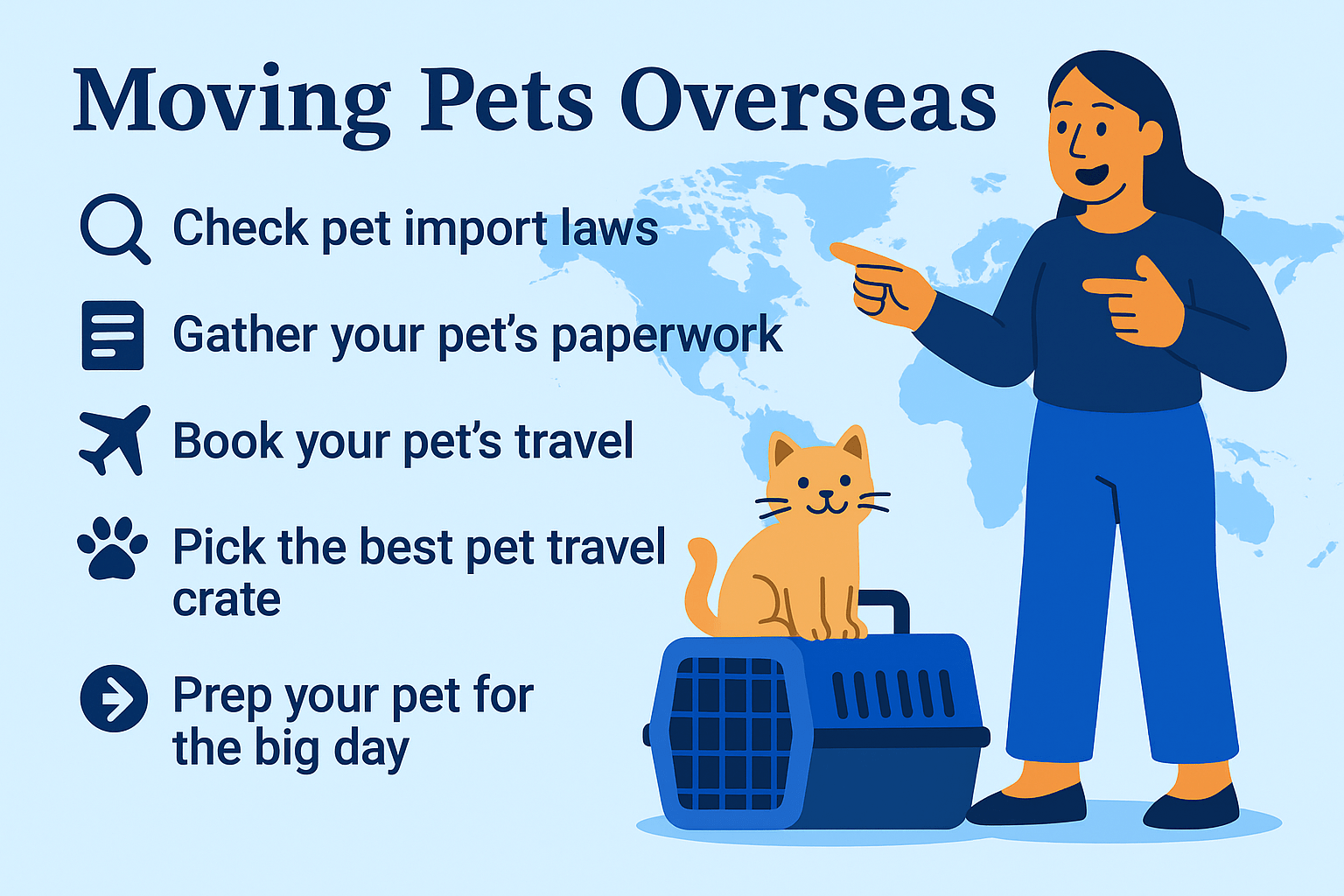Moving Pets Overseas: 2025 Guide
Moving a pet overseas will require additional planning beyond an already-jam-packed moving process. This includes getting the necessary medical records and documentation together, booking transportation for your pets, and planning for local regulations around pet imports before your arrival:
Key steps:
- Check import laws. Checking your destination’s regulations surrounding pet imports is vital. This will help you to prepare for quarantines or get any additional vaccinations for your pet.
- Gather health documents. Procuring a clean bill of health from a USDA-certified vet will satisfy many foreign customs requirements.
- Purchase a travel crate. Buying an IATA-approved travel crate will ensure your pet’s comfort and your compliance with airline regulations before travel.

Note that many of the top international moving companies will not offer dedicated pet transportation options, requiring you to book their travel separately through one of the options here. We recommend carefully planning for all of your companion’s travel accommodations with the same attention you apply to your overseas relocation.
Check pet import laws for your new country
Having a pet will alter your moving checklist when relocating to another country. All nations have unique breed and other restrictions governing which pets are allowed and under which terms they’re able to enter through customs.
Almost universally, these requirements include:
- Rabies vaccine
- Clean bill of health from a licensed veterinarian
- Microchip
Many countries also have quarantine requirements, which can range from a few hours to a few months. You can often check US Department of Agriculture’s Animal and Plant Inspection Service (USDA-APIS) to see how your destination country regulates incoming pets.
Pet regulations govern the import and export of:
- Cats
- Dogs
- Ferrets
- Rabbits
- Rodents
- Hedgehogs and tenrecs
- Reptiles
- Amphibians
- Some bird species
Some countries also limit which dogs are allowed past customs. American pit bull terriers, rottweilers and Neapolitan mastiffs are among commonly restricted or excluded breeds.
Countries have varied requirements for pet imports. Australia and New Zealand have some of the most stringent standards, while Canada and Germany are more lax by comparison.
Take a look at some international pet laws
- Australia: Pets entering Australia must have an ISO-compliant microchip with a 15-digit code. Beyond this, all pets coming from the states must have a rabies vaccine with an accompanying antibody test. Dogs must also have leptospirosis, distemper, hepatitis, parvovirus and parainfluenza vaccinations.
- New Zealand: Cats and dogs entering New Zealand have strict health and vaccination requirements. This includes a minimum quarantine period of 10 days when coming from the US. You also can’t bring live birds into the country, and must comply with restrictions for many rodent species.
- United Kingdom: The UK and many European countries require pets to have a dedicated passport. All pets must also get a clean bill of health from a USDA-approved vet before entering the country. The UK also requires a microchip, rabies vaccine and tapeworm treatment for dogs.
- Canada: Canada places some restrictions on dangerous dog breeds, but this varies by province. American pit bull terriers commonly feature on these lists. Other than that, you’ll need a health certificate from a USDA-approved vet and proof of a rabies vaccine. Some animals, like rabbits, do not require documents or permits.
- Germany: Germany’s requirements for pet imports are fairly straightforward. You’ll have to have a rabies vaccine, microchip and a clean bill of health from a USDA-approved vet for most pets to gain entry.
Get your pet’s paperwork in order
Nearly all countries will require documentation of some kind for you to bring your pet past customs. The specific documents will vary, depending on the type of pet, breed, local regulations and permitting requirements.
Common customs requirements for pets:
- Health certificate: Go to a USDA-certified veterinarian and get your pet’s ability to travel verified.
- Vaccination records: This often accompanies the above certificate. Most countries require a rabies vaccine, while some require an accompanying antibody test.
- Chip records: Microchips are commonly required to import a pet of any kind to a foreign country.
- Local importation permit: Many countries require a separate permit to import a pet. In the EU, this can include a pet passport. Look into a country’s rules and regulations before moving.
Book your pet’s travel arrangements
You’ll have options when booking travel accommodations for your pet during a move. The easiest option will be to book transit via air travel. Many airlines offer in-cabin options, but you may need to book cargo hold transit for larger pets. You’ll have to look into their requirements for travel, as some may mandate that you have up-to-date health records for your pet.
Some major airlines offering in-cabin transit include:
- American Airlines
- Delta Airlines
- United Airlines
- Alaska Airlines
Another option is contacting a standalone pet transportation and shipping service. Feather and Fur Express states that the average cost of this service ranges between $1,000 and $6,000, depending on the distance traveled.
Choosing the right travel method for your pet
When planning an overseas move, pet shipping can add a significant amount to your international moving costs. The cheapest of your most accessible options is in-cabin transportation, which is only viable for smaller pets that can be brought with you as a carry-on. The most expensive choice is contacting a pet shipping company.
In-cabin pet travel: Pros & cons
This is the best choice for small pets if you’re flying with an airline that allows for such accommodations. You’ll pay a few hundred extra for this option.
- Has relatively low costs
- Offers the most convenience of any pet transport option
- Is a lower-stress option for your pets
- Is not viable for most larger pets
- Provided by a limited number of airlines
Airplane cargo pet travel: Pros & cons
If you have a larger pet that you’d like to reach your destination as soon as possible, air freight via a cargo hold is the best choice.
- Provides ample room for larger pets
- Offers the same efficiency as in-cabin transport
- Is often quieter than in-cabin transport
- Can be prone to pressure and temperature issues
- Is often stressful for pets
Pet relocation service: Pros & cons
Companies that specialize in domestic and international pet relocations offer more services in the field, which often come at a more premium price point.
- Offers personalized care for your pets
- Can provide assistance with customs clearance
- Has door-to-door service options
- Is a higher-cost option for most pet owners
- Requires lengthier separation between pets and owners
Pick the right pet travel crate
Nearly all airlines require that you have a hard-shell pet crate made of plastic, wood or metal with a metal grate opening at one or both ends. They also require that your pet have enough space to stand up and comfortably turn around inside their carrier. Most medium or large carriers cost between $100 and $200, but you’ll find some higher-cost, sturdier options that cost more.
To size your container, the International Air Travel Authority (IATA) has specific regulations. Container length must equal your pet’s length, plus half of its height. Height must equal at least head height plus bedding height, and width must be double your pet’s width.
The above size recommendations are most important when placing your pet in a cargo hold for travel, although we recommend adhering to them for in-cabin travel. For the sake of your pet and everyone on the plane, you should ensure that your pet is crate trained before flying or transporting them overseas.
Prep your pet for the big day
Aside from your typical moving checklist, there are a few steps you’ll have to take to make sure that your pets are ready for travel.
These include:
- Crate training: Get your pet acclimated to spending time in your chosen crate. This could involve having them sleep in the space for multiple nights before travel.
- Vet appointment: Getting all necessary health certifications and vaccinations will help to make your pet’s transition to a new home far less stressful and hectic. It will help ensure that there aren’t any holdups or added quarantines at your destination.
- Check for quarantines or regulations: While checking for pet import regulations will have been a key step in your move prep, you should check again within a month of your move to be sure that no new laws or regulations have been put in place.
- Pack in-flight items for your pet: Pack quiet toys and snacks for your pet to bring with you during your flight. This mostly applies if you’re opting for in-cabin transport.
Pet-friendly international movers
Booking a professional international moving company is a necessity when relocating overseas. Such movers have the needed expertise and track records operating in other countries to make your move as stress-free as possible.
Unfortunately, companies like International Van Lines and JK Moving do not offer dedicated pet services.
We recommend contacting the following companies to coordinate this:
How to help your pet adjust to living abroad
Both you and your pet will have to acclimate to your new surroundings. Here are a few ways to get your companion comfortable in new surroundings:
- Take your time: Introduce your pet to your new home room by room. Moves are stressful for everyone involved, and animals are no different.
- Provide some familiarity: Try to take as many of their toys with you as you can. Filling their immediate living space with items they’re used to will put your pets more at ease.
- Spend time with your pet after your move: If possible, spending a lot of time at home with them will help to give your pets peace of mind. Separation anxiety can set in quicker in new surroundings.
The world’s most pet-friendly countries
Aside from finding a favorable country for your own interests like solid employment or lower cost of living, you may want to consider how life will be for your pet upon arrival.
Here are some of the top choices for pet owners:
- Canada: Canada makes the list due to the ease of moving here overall. Its proximity makes for a more stress-free relocation for your pet, and regulations on such imports are straightforward.
- Germany: This country is known for its humane treatment of animals. Like some other countries on this list, pets are a common fixture in public places.
- Switzerland: Dogs and pets are commonly permitted in public spaces here, although regulations are more stringent on importation.
- France: Like many European countries, you’ll need a pet passport to import a cat or dog here. However, pet ownership is common here.
- United Kingdom: The UK offers pet owners with plenty of pet-centric attractions. In addition, London and many other locales increasingly allow for dogs and some other pets in public areas.
- Australia: While importing a pet to Australia is difficult, many areas offer off-leash areas for dogs. Pet ownership is also common here.
- The Netherlands: This country features a pet-friendly culture, with pets allowed on public transport and at some restaurants.
FAQ
How much does it cost to move a pet overseas?
It costs between $2,000 and $6,000 to move a pet overseas. This includes actual shipping costs, vet expenses and more.
How hard is it to move internationally with pets?
This varies, depending on the country you’re moving to. However, it will always be more difficult to relocate overseas or across borders with a pet. Each country has varied clearance and medical requirements for pets establishing residency.
How long does pet quarantine last?
These periods are different with each country. Malaysia requires at least a seven-day quarantine for pets arriving from the US. Australia has a similar 10-day quarantine. This can range up to 180 days, which is required in Japan for certain pets that do not meet entry requirements including having an ISO-compliant microchip.
Can my emotional support dog fly internationally with me?
Emotional support animals are now treated as pets across all airlines. So, you’ll have to fly with an airline that allows pets in the cabin if you don’t want to stow your pet in cargo. Delta, American Airlines, Air France, Lufthansa and more allow this for an added fee.
What happens if my pet doesn’t meet the entry requirements?
If your pet is declined entry at your destination country, a couple of things could happen next. The most common outcome will be placement in quarantine for a period of time to be determined by the country in question. If there is no reasonable path for entry, you may be forced to return your pet to the states.
What can I give my dog to keep him calm while flying?
While sedatives aren’t allowed on flights, there are a few things you can do ahead of time to keep your furry friend calm on a plane. First, get them accustomed to your pet carrier by having them spend more time in it. Next, prepare to let them travel with a favorite toy or blanket. Finally, working in tandem with your vet to administer natural calming aids like amino acids can help them to sleep through most of your travel time.
How we chose the best moving companies
The moveBuddha team has spent nearly 10 years evaluating moving companies using a rigorous review system to identify the best moving companies. Our thorough methodology evaluates each moving company's services, cost, customer service, and reputation:
Moving services (35%):
We verify operating authority, insurance, and service scope against FMCSA/SAFER and state databases. We confirm availability via standardized mystery-shopping calls (packing tiers, storage type, specialty handling, delivery windows, valuation), and then review contracts alongside complaint and claims patterns over time.
Customer feedback (28%):
We run structured post-move surveys through our Better Moves Project with verifiable documentation. We emphasize on-time performance, care of goods, and estimates’ accuracy, and we investigate outliers before they influence scores.
Online reviews (7%):
We aggregate ratings across multiple third-party sites to reduce platform bias, analyze overall trends and company response behavior, and discount obvious spam/fake signals such as sudden bursts, duplicate language, and low-history profiles.
State availability (12%):
We confirm USDOT numbers, broker vs. carrier status, and any required state permits, then score a state-by-state service matrix that accounts for coverage gaps, seasonal limits, and lane strength. We award additional credit for documented cross-border or specialty lanes.
Additional services (12%):
We verify whether add-ons are performed in-house or subcontracted, look for crew training/certifications for high-value or oversized items, count only documented offerings (tariffs, photos, written service descriptions) confirmed via mystery shopping, and reward robust pre-move planning (virtual surveys, itemized crating).
Quotes/Payment options (6%):
We test standardized move profiles to assess estimate type (binding, not-to-exceed, non-binding), line-item transparency, and disclosed surcharges, require clear written policies for deposits, refunds, and cancellations, and award points for secure, flexible payment methods and customer portals.
Not what you were looking for?
Check out other categories that can help you find the information you need!

